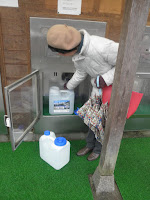January 30, 2016
Strong cold waves remind Japanese of importance of water for life
 Heavy snow storms hit many parts of the Japanese Archipelago late in January, waking Japanese up from a remaining doze after the New Year's holidays. Cold waves coming down from Siberia threaten to paralyze transportation systems in Japan every winter. This is just a usual scene for many Japanese, particularly those living in snowy northern areas. But the latest cold waves left hundreds of thousands of households without water supply for a few days in western and southwestern Japan.
Heavy snow storms hit many parts of the Japanese Archipelago late in January, waking Japanese up from a remaining doze after the New Year's holidays. Cold waves coming down from Siberia threaten to paralyze transportation systems in Japan every winter. This is just a usual scene for many Japanese, particularly those living in snowy northern areas. But the latest cold waves left hundreds of thousands of households without water supply for a few days in western and southwestern Japan. Outdoor water pipes got frozen and broke down, causing a leakage of water in more than 10 prefectures in Kyushu, southwestern Japan. The level of water in service reservoirs declined, forcing municipalities to cut water supply to houses in areas involved.
Outdoor water pipes got frozen and broke down, causing a leakage of water in more than 10 prefectures in Kyushu, southwestern Japan. The level of water in service reservoirs declined, forcing municipalities to cut water supply to houses in areas involved.Affected people formed long lines in front of mobilized water supply cars, carrying with them plastic water tanks. The less snowy region of Kyushu was hit by unusually strong cold waves twice in about a week this winter. The snow storms came in from the west, and snowfalls were also officially observed in Okinawa, southernmost Japan, for the first time ever.
 Residents of northern Japan usually leave the water flowing all the time in the winter time, or cover conduit pipes with insulating materials, but those in southern regions have no such customs
Residents of northern Japan usually leave the water flowing all the time in the winter time, or cover conduit pipes with insulating materials, but those in southern regions have no such customsOfficials in cities involved explained the water supply cut was necessary, because they needed time to locate the places where water was leaking, before resuming water supply. They also asked households with wells to share their water with neighboring people.
Water from the Iwaya Foundations can be drawn at a facility set up in front of the Japanese Railways Chikuzen-Iwaya Station in Toho Village, Fukuoka Prefecture. The water is rich with minerals, as it comes from among solid rock beneath the nearby Mt. Shakadake with an elevation of 844 meters.
The foundations originate from a water vein, which was hit in the course of work to dig a 4,300-meter tunnel under the mountain from 1937
 The water at the foundations never gets frozen or dries up, said a man who came to get the water at the facility. The man, who is in his 70s, said he has drawn the water for over 10 years.
The water at the foundations never gets frozen or dries up, said a man who came to get the water at the facility. The man, who is in his 70s, said he has drawn the water for over 10 years."We use this water when we cook rice or drink coffee and tea," he said. "The water here is very nice. It is not too hard, not too soft, and there is no impurities, either."
Up to 30 liters of water can be drawn for 100 yen at the facility.
 Near the facility is something like a small rock garden. Water springs out from between the rocks there. Before the facility was set up, people drew water with no charge there, according to the man.
Near the facility is something like a small rock garden. Water springs out from between the rocks there. Before the facility was set up, people drew water with no charge there, according to the man.Water supply gradually returned to normal in the affected areas in Kyushu. But the latest cold waves have reminded Japanese people that water is more important than anything else for their daily life. They also told people that drinking water cannot be easily obtained anytime.
There occur abnormal meteorological phenomena in various parts of the world. Japanese people maybe this time have learned that they will also have to be better prepared to keep their life amid the changing climate all the time.